Synthesizers are transforming underground metal by enhancing sound design and expanding the genre’s sonic palette. This article explores the integration of synthesizers, the challenges musicians face, and unique sound design techniques. It also highlights rare synthesizer models that are sought after in the scene. Finally, effective strategies for balancing synthesizers with traditional metal elements will be discussed.
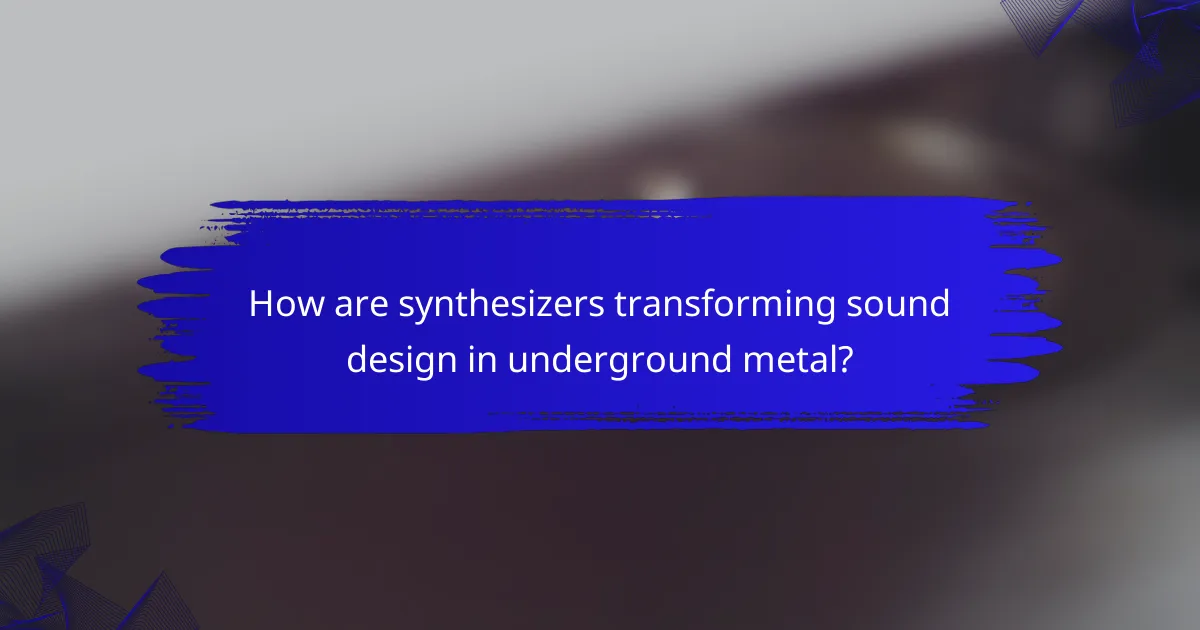
How are synthesizers transforming sound design in underground metal?
Synthesizers are revolutionising sound design in underground metal by introducing innovative textures and layers. They expand the genre’s sonic palette, allowing for unique soundscapes that blend traditional metal elements with electronic influences. This integration enhances creativity and experimentation, enabling artists to create immersive experiences. For example, synthesizers can emulate orchestral sounds or produce ambient effects, enriching the overall atmosphere of the music. As a result, underground metal increasingly embraces synthesizers to differentiate itself and push artistic boundaries.
What are the key sound characteristics of synthesizers in this genre?
Synthesizers in underground metal are characterised by aggressive tones, complex textures, and heavy distortion. These sound characteristics create a unique atmosphere that enhances the genre’s intensity.
Key features include:
– **Aggressive tones**: Often achieved through harsh waveforms and modulation techniques.
– **Complex textures**: Layering multiple sounds to create rich sonic landscapes.
– **Heavy distortion**: Used to give a raw, powerful edge to the sound.
– **Dark atmospheres**: Incorporating ambient elements to add depth and mood.
– **Unique sound design**: Custom patches tailored to fit the specific aesthetic of underground metal.
These attributes collectively define the role of synthesizers in shaping the sound of underground metal.
Which synthesizer types are most popular among underground metal musicians?
Analog synthesizers are most popular among underground metal musicians due to their rich, warm sound and versatility. These instruments allow for unique sound design, crucial for creating atmospheric and heavy tones. Modular synthesizers also gain traction, offering customisation and complex signal routing. Additionally, digital synthesizers are favoured for their affordability and diverse sound libraries, making them accessible for experimentation within the genre.
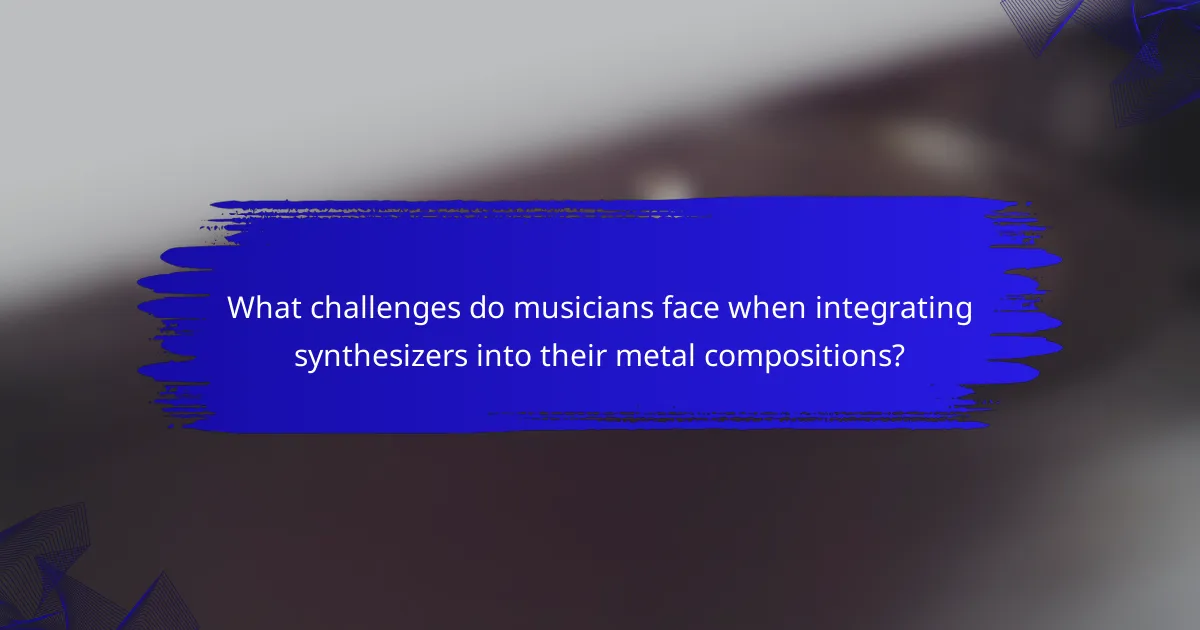
What challenges do musicians face when integrating synthesizers into their metal compositions?
Musicians face several challenges when integrating synthesizers into metal compositions. These include achieving a balanced mix between traditional instruments and synthesizers, maintaining the genre’s aggressive sound, and ensuring the synthesizers complement rather than overpower the guitar riffs.
Additionally, the complexity of sound design can be daunting, requiring a deep understanding of both synthesizer capabilities and metal aesthetics. Musicians often struggle with the technical aspects, such as programming and sound layering, which can lead to a steep learning curve.
Another challenge is the perception of synthesizers within the metal community, where they may be viewed as less authentic. Overcoming this stigma requires innovative approaches to sound integration that respect the genre’s roots while pushing creative boundaries.
Finally, live performance logistics present obstacles, such as the need for additional equipment and the potential for technical issues during shows. These factors can complicate the seamless integration of synthesizers into live metal performances.
How do musicians overcome technical issues with synthesizers?
Musicians overcome technical issues with synthesizers through preparation, experimentation, and collaboration. They often troubleshoot by having backup gear and understanding their instruments deeply.
Regular practice helps them anticipate potential problems. Experimentation with sound design allows musicians to adapt quickly to unexpected challenges. Collaboration with sound engineers or other musicians provides fresh perspectives and solutions to technical hurdles.
Utilising online resources and forums can also aid in resolving specific issues. Overall, a proactive approach and willingness to learn enhance their ability to manage synthesizer challenges effectively.
What are common misconceptions about synthesizers in metal music?
Many believe synthesizers lack authenticity in metal music, but they enhance creativity and sound design. Misconceptions often stem from a traditional view of metal, emphasising guitar-driven sound. Synthesizers can create atmospheric layers, enriching compositions. Additionally, some think synthesizers are only for mainstream genres, yet underground metal bands increasingly embrace them for unique textures. This integration showcases the versatility of synthesizers, proving they are valuable tools in expanding metal’s sonic landscape.
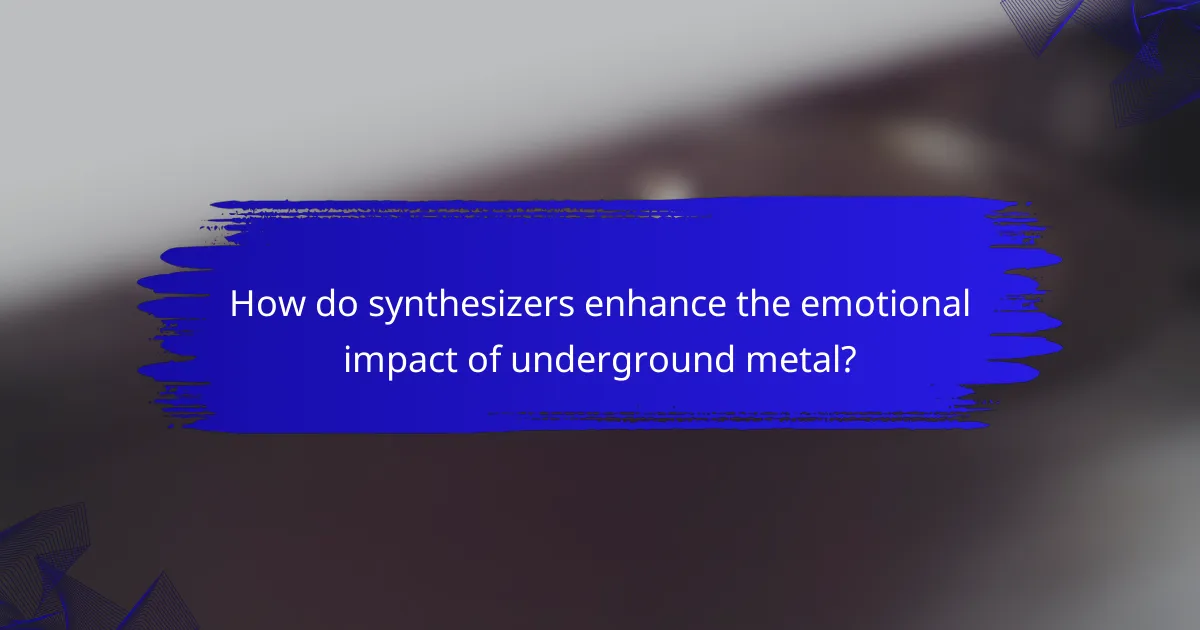
How do synthesizers enhance the emotional impact of underground metal?
Synthesizers enhance the emotional impact of underground metal by adding depth and texture to the sound. They create atmospheric layers that evoke feelings of intensity and darkness. This integration allows for unique soundscapes, setting a distinct mood that resonates with listeners. For example, synthesizers can produce haunting melodies or ominous drones, which amplify the lyrical themes often found in this genre. Their ability to manipulate sound contributes to a more immersive experience, allowing artists to express complex emotions effectively.
What role do synthesizers play in creating atmospheric soundscapes?
Synthesizers are crucial in creating atmospheric soundscapes in underground metal. They add depth and texture, enhancing the overall emotional impact of the music.
Synthesizers can generate a variety of sounds, from haunting pads to aggressive leads, providing unique audio experiences. Their ability to manipulate timbre and dynamics allows for intricate layering, which is essential in crafting immersive environments.
The integration of synthesizers in underground metal often involves unique attributes, such as the use of modular systems or vintage equipment, which contribute distinctive sonic qualities. This approach helps bands differentiate their sound in a crowded genre.
As a result, synthesizers serve not only as instruments but also as tools for sound design, pushing the boundaries of traditional metal music.
Which notable underground metal bands effectively utilize synthesizers?
Notable underground metal bands that effectively utilise synthesizers include Fleshgod Apocalypse, Eluveitie, and Septicflesh. These bands integrate synthesizers to enhance their soundscapes, creating a unique blend of orchestral elements and heavy instrumentation.
Fleshgod Apocalypse employs symphonic elements through synthesizers, enriching their operatic death metal style. Eluveitie combines traditional folk instruments with synthesizers, adding depth to their melodic death metal sound. Septicflesh utilises synthesizers to create atmospheric layers, contributing to their cinematic metal approach.
Each band exemplifies how synthesizers can expand the sonic palette of underground metal, offering diverse auditory experiences. This integration showcases the versatility of synthesizers beyond traditional genres, pushing the boundaries of metal music.
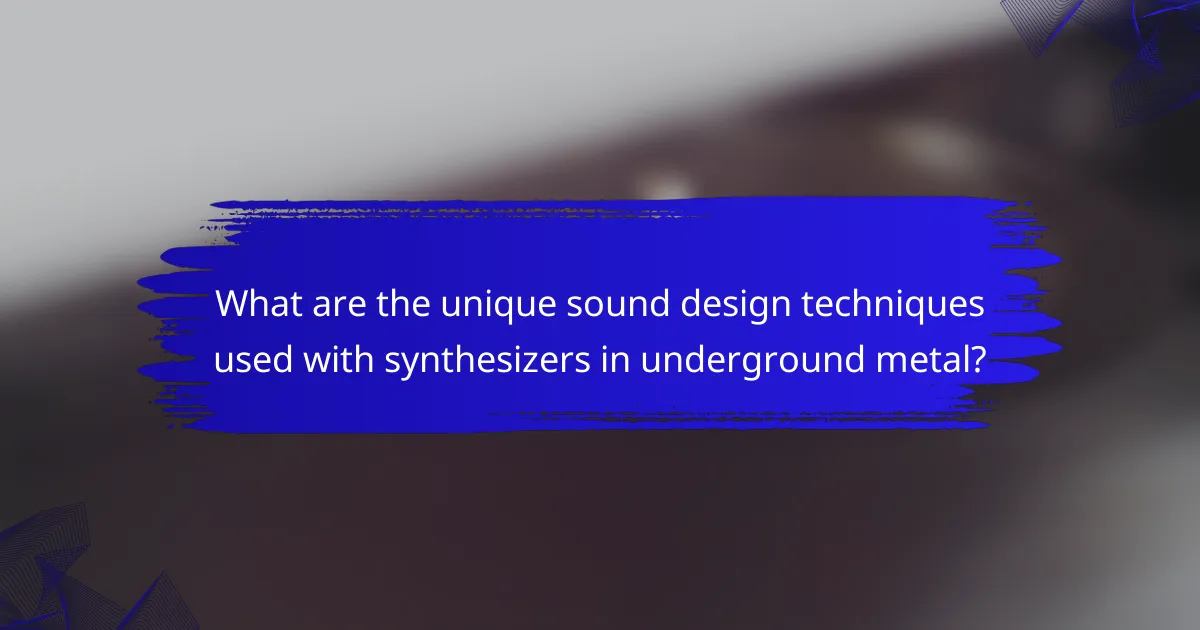
What are the unique sound design techniques used with synthesizers in underground metal?
Unique sound design techniques in underground metal using synthesizers include layering, modulation, and unconventional sound sources. These methods create distinctive textures and atmospheres.
Layering involves stacking multiple synth sounds to build a rich sonic landscape. Modulation adds movement and complexity, using LFOs or envelopes to alter parameters dynamically. Unconventional sound sources, like field recordings or sampled noise, contribute unexpected elements, enhancing the genre’s experimental nature.
Synthesizers often employ effects like distortion and reverb to further shape sound. These techniques allow underground metal artists to push boundaries and create immersive listening experiences.
How can layering synth sounds create depth in metal tracks?
Layering synth sounds enhances depth in metal tracks by creating rich textures and complex soundscapes. This technique allows for a fuller sonic experience, blending electronic elements with traditional metal instrumentation. Synths can fill frequency gaps, adding warmth and atmosphere, which complements heavy guitar riffs. For instance, using multiple synth layers can produce a lush backdrop, making the overall mix more immersive. The unique characteristic of synthesizers lies in their ability to generate a wide range of sounds, from ambient pads to aggressive leads, which can be tailored to fit the mood of each track.
What are innovative modulation techniques employed by underground metal artists?
Underground metal artists utilise innovative modulation techniques to create unique soundscapes. Techniques such as ring modulation, frequency modulation, and granular synthesis are prevalent. These methods enable artists to manipulate audio signals, resulting in complex textures and dynamic tonal variations. Additionally, the integration of modular synthesizers allows for real-time sound design, fostering creativity and experimentation. This approach enhances the genre’s distinctiveness, pushing the boundaries of traditional metal music.
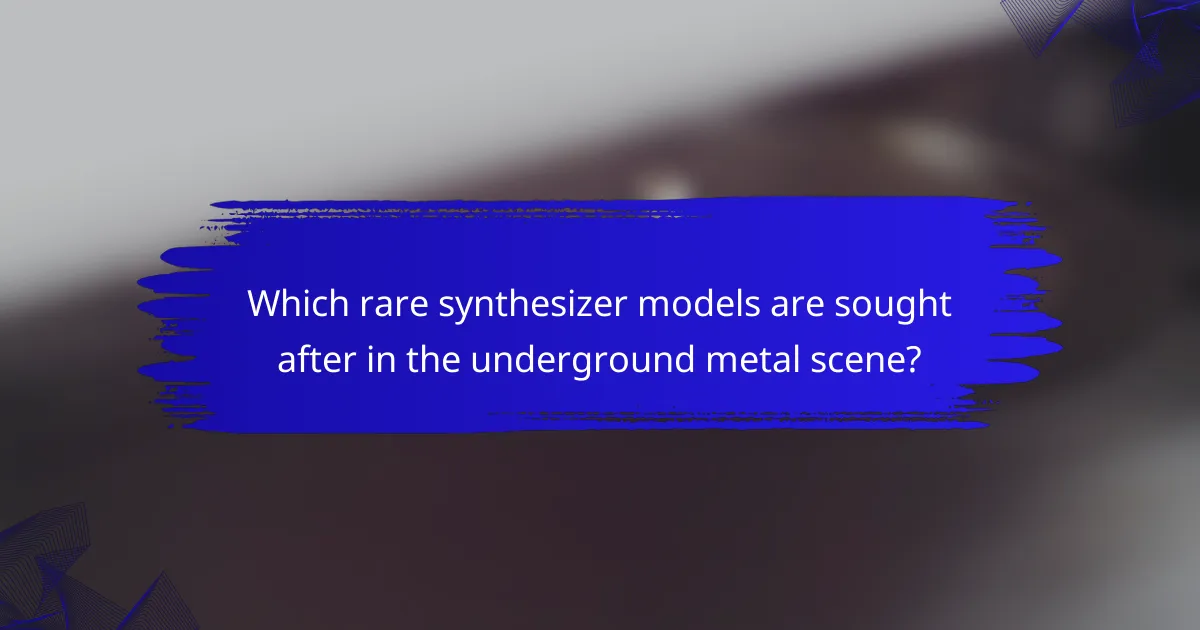
Which rare synthesizer models are sought after in the underground metal scene?
Rare synthesizer models sought after in the underground metal scene include the Roland SH-101, Korg MS-20, and the Moog Minimoog. These synthesizers are prized for their unique sound design capabilities and distinctive tones. The SH-101 is known for its punchy bass and leads, while the MS-20 offers a gritty filter and patchable architecture, making it versatile for experimental sounds. The Minimoog is celebrated for its rich analog warmth and iconic status in various genres, including metal. Collectors and musicians often seek these models for their rarity and the unique sonic character they bring to underground metal music.
What makes these rare synthesizers valuable to musicians?
Rare synthesizers are valuable to musicians for their unique sound design capabilities and limited availability. Their distinctive tonal qualities and innovative features often inspire creativity, making them sought after in underground metal. Additionally, these synthesizers can offer a one-of-a-kind character that enhances a band’s overall sound, setting them apart in a competitive genre. Their rarity also contributes to their market value, as collectors and musicians alike appreciate the historical significance and craftsmanship involved in their production.
How do artists source and maintain these unique synthesizers?
Artists source and maintain unique synthesizers through specialised networks and personal connections. They often explore vintage shops, online marketplaces, and music festivals to discover rare models. Collaborations with other musicians can lead to unique finds, as artists share resources and knowledge about specific synthesizers. Regular maintenance is crucial; artists often learn to repair and customise their instruments, ensuring longevity and optimal performance. Additionally, some engage with online communities for tips on upkeep and modifications, fostering a culture of innovation in sound design.

What best practices should musicians follow when incorporating synthesizers into underground metal?
Musicians should prioritise sound design, layering, and experimentation when incorporating synthesizers into underground metal. Focus on creating atmospheric textures that complement heavy instrumentation.
Utilise synthesizers to add depth and mood, enhancing the overall soundscape. Experiment with different types of synthesis, such as subtractive or FM, to find unique tones.
Layer synthesizer sounds with guitar riffs to create a fuller sound. Use modulation effects to add movement and interest, avoiding static sound.
Consider the dynamics of the mix; synths should enhance rather than overpower the core metal elements. Balance is key to achieving a cohesive sound.
How can artists effectively balance synthesizers with traditional metal instrumentation?
Artists can balance synthesizers with traditional metal instrumentation by integrating layers and textures. Combining the aggressive tones of metal with the atmospheric qualities of synthesizers enhances depth.
One effective method is to use synthesizers for ambient backgrounds, allowing traditional instruments to take the forefront. This creates a dynamic contrast that maintains metal’s intensity while adding a modern twist.
Additionally, artists can experiment with synth leads during solos, blending electronic elements with guitar riffs. This approach enriches sound design and keeps the music engaging.
Finally, careful attention to mixing ensures that synthesizers complement rather than overpower traditional instruments. Achieving this balance can elevate the overall sound, making it unique and compelling.
What common mistakes should be avoided during sound design with synthesizers?
Common mistakes to avoid during sound design with synthesizers include overusing effects, neglecting sound layering, and ignoring frequency balance. These issues can lead to a muddy mix and lack of clarity in the overall sound.
Failing to experiment with modulation options can limit creativity. Additionally, not considering the context of the music genre may result in sounds that clash with the intended style.
Properly addressing these mistakes enhances the integration of synthesizers in underground metal, ensuring a powerful and cohesive sound design.